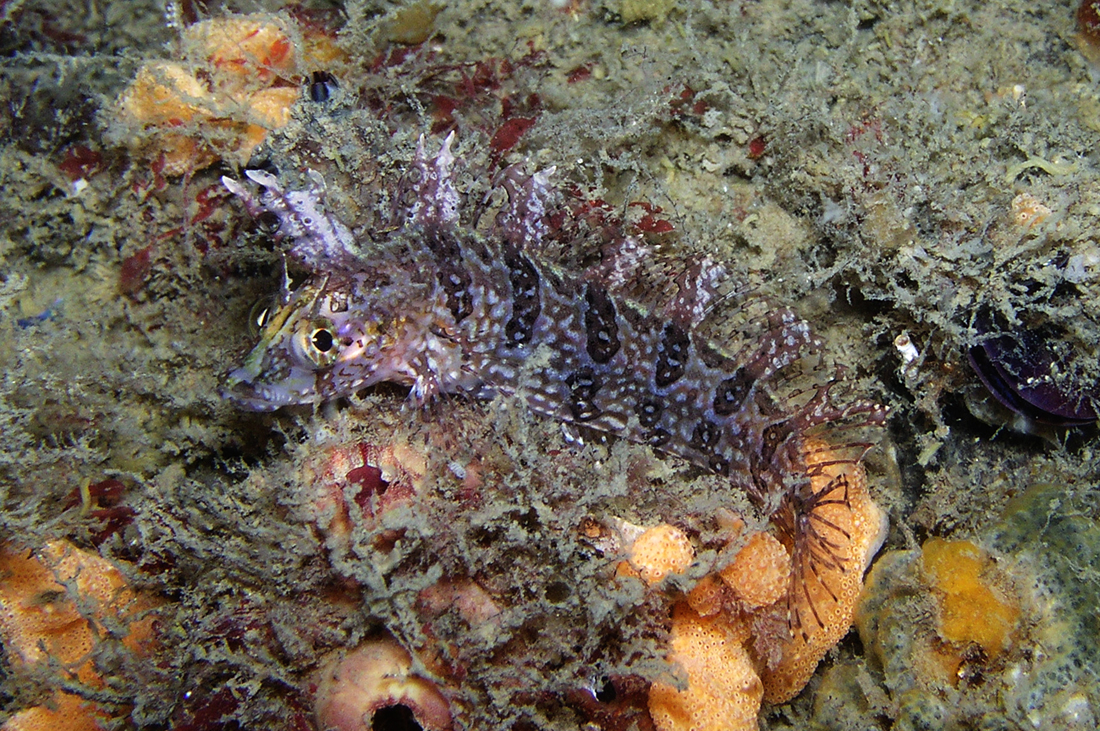Longnose Weedfish, Heteroclinus tristis (Klunzinger 1872)

A Longnose Weedfish, Heteroclinus tristis, at Schnapper Point, Mornington, Port Phillip, Victoria, May 2009. Source: Sascha Schultz / iNaturalist.org. License: CC BY Attribution-NonCommercial
A large yellowish to reddish or brown weedfish, usually with a mosaic pattern of spots and bands, large white spots on the lower part of the head and belly, a dark bar from the eye to the rear of the jaw, and many small transparent patches on the fins. Longnose Weedfish have a long tapering snout, a very large mouth, and the first dorsal fin arising on top of the head behind the eye and not connected to the second dorsal fin. They have a long, slender orbital tentacle, sometimes with several small lateral lobes, and a simple nasal tentacle.
.
Longnose Weedfish, Heteroclinus tristis (Klunzinger 1872)
More Info
|
Distribution |
Endemic to temperate waters of southern Australia, from Sydney, New South Wales, to the Recherche Archipelago, Western Australia, including around Tasmania. The Longnose Weedfish usually lives amongst macroalgae on sandy bottoms and shallow rocky outcrops, at depths to 5 m. |
|
Features |
Dorsal fin III, XXVIII-XXX, 3-5; Anal fin II, 23-25; Caudal fin (segmented rays) 9-11; Pectoral fin 10-12; Pelvic fin I, 3; Lateral line scales (arched) 20-27 + (straight) 26-32; Gill rakers 2 + 7-10 = 9-12. Males have a higher first dorsal fin than females. |
|
Size |
To 30 cm. |
|
Colour |
Variably yellowish, to reddish and brown, usually with complex markings including dark spots, and a mosaic pattern of yellowish spots and bands; lower part of head and belly with large white spots, a dark bar from eye to end of jaws; fins with many small transparent patches, fin-tips sometimes yellow. |
|
Feeding |
Carnivores - feed on small fishes and invertebrates. |
|
Biology |
The sexes are separate and males have an intromittent organ for internal fertilisation. Australian weedfishes are ovoviviparous - meaning that the young develop inside eggs and hatch within the female before the well-developed larvae are born live. Individual females usually carry multiple batches of eggs and/or embryos at the same time. |
|
Fisheries |
Of no interest to fisheries. |
|
Conservation |
|
|
Species Citation |
Cristiceps tristis Klunzinger 1872, Archiv für Naturgeschichte 38(1): 31. Type locality: Murray River, South Australia. |
|
Author |
Bray, D.J. 2020 |
|
Resources |
Longnose Weedfish, Heteroclinus tristis (Klunzinger 1872)
References
Cristiceps tristis Klunzinger, C.B. 1872. Zur Fische-fauna von Süd Australien. Archiv für Naturgeschichte 38(1): 17-47 pl. 2 (p. 31, as Cristiceps tristis)
Castelnau, F.L. de 1872. Contribution to the ichthyology of Australia. 1. The Melbourne fish market. Proceedings of the Zoological and Acclimatisation Society of Victoria 1: 29-242 1 pl (p. 131, as Cristiceps multifenestratus)
Castelnau, F.L. de 1872. Contribution to the ichthyology of Australia. 1. The Melbourne fish market. Proceedings of the Zoological and Acclimatisation Society of Victoria 1: 29-242 1 pl (p. 132, Cristiceps forsteri)
Castelnau, F.L. de 1873. Contribution to the ichthyology of Australia. 3. Supplement to the fishes of Victoria. Proceedings of the Zoological and Acclimatisation Society of Victoria 2: 37-58 (p. 48, as Cristiceps amaenus)
Coleman, N. 1980. Australian Sea Fishes South of 30ºS. Lane Cove, NSW : Doubleday Australia Pty Ltd 309 pp. (p. 256, as H. forsteri)
Edgar, G.J. 2008. Australian Marine Life: the plants and animals of temperate waters. Sydney : Reed New Holland 2, 624 pp.
Gunn, J.S. & Thresher, R.E. 1991. Viviparity and the reproductive ecology of clinid fishes (Clinidae) from temperate Australian waters. Environmental Biology of Fishes 31: 323-344.
Hindell, J.S., Jenkins, G.P. & Keough, M.J. 2000. Variability in abundances of fishes associated with seagrass habitats in relation to diets of predatory fishes. Marine Biology 136(4): 725-737.
Hoese, D.F., Gomon, M.F. & Rennis, D.S. 2008. Family Clinidae. pp. 696-722 in Gomon. M.F., Bray, D.J. & Kuiter, R.H (eds). Fishes of Australia's Southern Coast. Sydney : Reed New Holland 928 pp.
Kuiter, R.H. 1993. Coastal Fishes of South-eastern Australia. Bathurst : Crawford House Press 437 pp.
Kuiter, R.H. 1996. Guide to sea fishes of Australia. A comprehensive reference for divers and fishermen. Sydney, NSW, Australia : New Holland Publishers xvii, 434 pp.
Last, P.R., Scott, E.O.G. & Talbot, F.H. 1983. Fishes of Tasmania. Hobart : Tasmanian Fisheries Development Authority 563 pp. figs (p. 434, as H. forsteri)
McCulloch, A.R. 1915. Notes on and descriptions of Australian fishes. Proceedings of the Linnean Society of New South Wales 40(2): 259-277 pls 35-37 (p. 275, pl. 37(3), as Petraites incertus)
Rennis, D., Hoese, D.F. & Gomon, M.F. 1994. Family Clinidae. pp. 741-775, figs 650-684B in Gomon, M.F., Glover, C.J.M. & Kuiter, R.H (eds). The Fishes of Australia's South Coast. Adelaide : State Printer 992 pp. 810 figs
Williams, J.T., Holleman, W. & Clements, K.D. 2014. Heteroclinus tristis. The IUCN Red List of Threatened Species 2014: e.T179079A1567268. http://dx.doi.org/10.2305/IUCN.UK.2014-3.RLTS.T179079A1567268.en. Downloaded on 17 August 2016.












